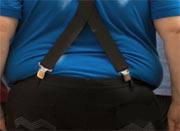
TUESDAY, Dec. 14 (HealthDay News) — Two reports from the U.S. National Center for Health Statistics show that the obesity epidemic is hitting young and older Americans across the economic
spectrum.
The NCHS, part of the U.S. Centers for Disease Control and Prevention, released the reports on Tuesday. Looking at both adults and children, they compared obesity rates using national data from 1988 to 1994 and from 2005 to 2008, using data from the National Health and Nutrition Examination Survey.
Overall, “the prevalence of obesity increased in adults at all income and education levels,” during that time, the authors said, and the same general trend held for American children. They noted that by 2008 more than a third of American adults were obese, as well as nearly 17 percent of children and adolescents aged 2 to 19 years.
There were some disparities based on income. For example, among adult males, obesity was similar across income levels, although for black and Hispanic men rates of obesity tended to rise along with income. On the other hand, higher-income women were less likely to be obese compared to their less affluent peers.
Among children, low family income was tied to a higher likelihood of obesity, but the association was not consistent across all racial and ethnic groups. The NCHS team also stressed that “most obese children and adolescents are not low income,” defined as below 130 percent of the poverty line.
In terms of education, the researchers found no significant trend linking education and a tendency toward obesity for men. However, women with college degrees were less likely to be obese compared to women without higher education.
Children raised in homes where the head of household had a college degree were less prone to become obese versus kids raised in households headed by someone without such education. However, this relationship was not consistent across race and ethnicity groups, the NCHS report found.
More information
There’s more on keeping overweight at bay at the U.S. National Library of Medicine.

